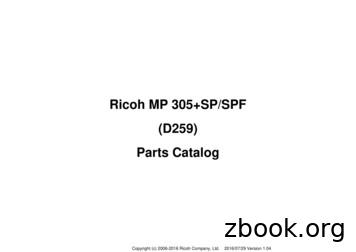Modern And Traditional Business Management: An Overview Of .
Modern and Traditional BusinessManagement: An Overview of Two IdealTypes of Management, their Differencesand Influences on Performance.Master of Business AdministrationManagement Studies – Strategy and Organization22 July 2010Author: Viola Elise van Alphen 1584529Supervisor: Paul Vlaar1
Management summaryManagement literature exhibits trends over time, and a shift seems to occur fromattention for Traditional towards more Modern management approaches. This thesisexplores the main differences between both management approaches, and it assesseshow each of them relates to the other and to organizational performance.A literature review and an causal research using a questionnaire with 101respondents with a broad variety in gender, sectors of industry, job-level, et cetera,has been performed in Dutch trains in April 2010. Results indicate that differencesbetween traditional and modern management approaches pertain to at least sevendimensions: (1) Management Perspective; (2) Performance Horizon; (3) Rewards andSanctions; (4) Coordination and Control; (5) Attention Sphere; (6) ManagerialQualities; and (7) View on Core Resources.The empirical study suggests that the modern management approach not somuch substitutes but complements the more traditional approach. It comprises anaddition to traditional management, with internal motivation and intrinsic rewardshave a strong, positive effect on performance, and short term focus exhibiting anegative effect on performance.These findings contribute to the current discussion on the significance oftraditional and more modern management approaches. More specifically, it addressesquestions such as: what position do modern management approaches assume relativeto more traditional approaches? Do they constitute substitutes or complements? Arethey just a temporary trend in Western societies? These are important questions for allorganizations having an influence on their survival.The results of this study partly address my own curiosity. I was surprised by thepresence and charm of modern management theories during my education at theFaculty of Economics and Business Administration. I could hardly believe thatorganizations would actually believe in focusing on long term strategies and nurturingemployees (which sounds very Marxistic in my opinion) instead of purelyemphasizing fast-profit-making.In an interconnected, globalized world, where organizations have grown out ofhuman-size it seemed to me that organizations could only have main goals assatisfying shareholder by maximizing profit. I thought managers were opportunistic,using slave-like cheap labor and helpdesks didn’t help anymore, only make profits.Original values some organizations used to have, like meaningfulness and trying to2
take care of employees and the world seemed to me as if they lost the number onepriority. Therefore, I wanted to research if actually a difference between traditionaland more meaningful, modern organizations existed, and also I hoped to show that amore human and modern approach would lead to higher performance. And I did, bywriting this thesis.3
Table of contents1. Introduction . 61.1. Comparing management theories . 61.2. Research problem and research questions . 71.3. Theoretical and practical relevance . 91.4. Structure of the thesis . 101.5. Conclusion . 112. Theory . 122.1 Management perspective. 122.1.1. From the demanding outside . 142.1.2. From the positive core . 152.1.3. Proposition and conclusion . 172.2. Performance horizon . 172.2.1. Short term . 182.2.2. Long term . 192.1.3. Proposition and conclusion . 212.3. Rewards and sanctions . 212.3.1. Extrinsic motivation . 222.3.2. Intrinsic motivation . 232.3.3. Proposition and conclusion . 252.4. Coordination and control . 262.4.1. Explicit . 262.4.2. Implicit . 282.4.3. Proposition and conclusion . 312.5. Attention sphere. 312.5.1. Problem solving . 322.5.2. Opportunity recognition. 332.5.3. Proposition and conclusion . 352.6. Managerial qualities . 362.6.1. Push management. 372.6.2. Pull management . 392.6.3. Proposition and conclusion . 404
2.7. Core resources . 412.7.1. Tangible and intangible capital . 422.7.2. Social and psychological capital . 432.7.3. Proposition and conclusion . 442.8. Conclusion . 453. Methods . 453.1. Research design . 453.2. Data collection . 483.3. Operational definitions . 493.4. Data analysis . 494. Results . 514.1. Summary . 514.2. Scale development Reflective . 534.3. Scale development Formative . 584.4. Interpretation . 605. Discussion and Conclusion . 615.1. Main findings . 615.2. Theoretical and practical contributions of the findings . 635.3. Limitations and avenues for future research . 645.4. Conclusion . 66References . 67APPENDIX A: Questionnaire . 74APPENDIX B: Precise list of Sectors of Industry and Job titles . 77APPENDIX C: Tables . 835
Two ideal types of organizations in Business Management literature: anoverview of their differences and interrelations.The literature distinguishes two ideal types of organizational management theory, andit appears that two corresponding types of organizations co-exist in practice:Organizations that choose for a traditional management approach and organizationsthat choose for a modern management approach. In this thesis, I argue that theseideal types differ on at least seven dimensions: (1) Management Perspective; (2)Performance Horizon; (3) Rewards and Sanctions; (4) Coordination and Control; (5)Attention Sphere; (6) Managerial Qualities; and (7) View on Core Resources. Iempirically explore whether these dimensions indeed underlie different managementapproaches, and assesses how both approaches relate to each other and toorganizational performance. Results from a survey amongst 101 firms in theNetherlands confirm that differences amongst firms regarding the use of bothapproaches have a strong significant effect on performance. These findings contributeto the literature by providing insight in the merits of both management approaches,and their interrelationships as well as performance effects.1. IntroductionSince the early days of scientific business and organizational research, theorists haveargued that firms can realise benefits using either more traditional or more modernmanagement approaches. For example, Taylor, Weber and Fayol were famous socialscientists that advocated a traditional management. They are the founders oforganizational studies and started their theories in the beginning of the 20th century atthe beginning of the industrial era, focusing on technical aspects, competencies, rulesand discipline within management (Mullins, 2007, Bloisi et al 2003). Nowadays theworld has developed (multinationals, globalization, information technology) andmanagement books and management articles seem to take a more modernmanagement approach, focusing on the long term, human beings and the ability tounleash their capacities (Mullins, 2007).1.1.Comparing different management theoriesIn the scientific literature two ideal types of organizations and managementapproaches appear. A review of the literature suggests that these ideal types differ on6
at least 7 dimensions (see Figure 1). Theorists have emphasized one of thesemanagement approaches above the other, asserting how each influencesorganizational performance. This thesis, instead, investigates both approaches andascertains which one (or a combination) leads to superior organizational performance.1.2.Research problem and research questionsTraditional and more modern management approaches appear to differ on at leastseven dimensions: (1) management perspective; (2) performance horizon; (3) rewardsand sanctions; (4) coordination and control; (5) attention sphere; (6) managerialqualities; and (7) view on core resources (see Figure 1). A traditional managementapproach is an approach wherein an organization focuses on perspective fromdemanding outside, short term performance horizon, extrinsic rewards and sanctions,explicit coordination and control, problem solving attention sphere, explicit (push)managerial qualities and seeing tangible and intangible assets as the organizationscore resources (see Figure 1). A modern management approach, instead, suggests anorganization focuses on perspective from the positive core, long term performancehorizon, intrinsic rewards, implicit coordination and control, opportunity recognitionattention sphere, implicit (pull) managerial qualities and seeing social andpsychological capital as the organizations core resources (see Figure 1).From the theory it seems that organizations either choose for a Modern managementapproach, or they choose for a more Traditional management approach. Thedistinctions between these approaches will be further described in the theory-sectionof the
The empirical study suggests that the modern management approach not so much substitutes but complements the more traditional approach. It comprises an addition to traditional management, with internal motivation and intrinsic rewards have a strong, positive effect on performance, and short term focus exhibiting a negative effect on performance. These findings contribute to the current .
Modern Endpoint Management Modern Endpoint Management The modern management model 5 Traditional endpoint management assumes every device IT manages is owned by the organization and is connected to an on-premises network. Group policies lock down how each user operates the device as
CONTENTS Introduction to Business 3 International Business 3 Corporate Governance 3 Business Law 4 Business Research Methods 4 Business Ethics 5 Business Economics/Accounting 5 Business Communication 5 Business Statistics/Decision Sciences 6 Business and Management Information Systems 7 Entrepreneurship and Small Business Management 8 Project Management 8 Operations Management/Supply Chain .
workflow, from installing the software to accessing complex data sets, publishing interactive dashboards, and sharing across your organization. Speed at every stage. Compared to traditional business intelligence, modern business intelligence is 10 to 100 times faster at everystep. Where traditional systems can take months to implement, the modern
Ricoh MP 305 SP Ricoh MP 305 SPF D259 3D Paper Feed Unit PB1090 D794 3D NFC Card Reader Type M13 D3B4 Traditional Optional Counter Interface Unit Type M12 B870 Traditional Bluetooth Interface Unit Type D D566 Traditional XPS Direct Print Option Type M15 D3B4 Traditional SD Card for Fonts Type D D641 Traditional OCR Unit Type M13 D3AC Traditional
Modern Traditional Home Catalog 15. 01. 03. You can truly nail down the modern traditional . look with the thoughtful addition of nailhead . trim. A bold embellishment, this defining . detail dates back centuries as a way to secure upholstery in a decorative, dramatic fashion. practical above all
Modern's abc of Objective Chemistry Modern's abc of Objective Mathematics Modern's abc of Objective Biology Modern's abc of Crash Course Physics (JEE-Main) Modern's abc of Crash Course Chemistry (JEE-Main) Modern's abc of Crash Course Mathematics (JEE-Main) E info@mbdgroup.com W www.mbdgroup
of the non-traditional student journey. We explored the unique social and academic needs and expectations of non-traditional students, the barriers they encounter, and ways to help them achieve greater levels of success. More than 1,000 traditional students and nearly 800 non-traditional students participated in our survey, offering insights
Albert Woodfox were properly convicted for the 1972 murder of prison guard Brent Miller. Supporters of Wallace and Woodfox, who make up two-thirds of a group known to supporters as the "Angola Three," say that the convictions were at least partly because of the men's involvement with the Black Panther Party. "Under this new governor's office, this new day, we are making sure we right the .























